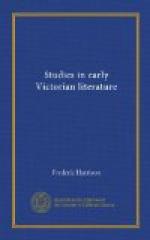The charm of the hour lay in its approaching dimness, in the low-gliding and pale-beaming sun. I was a mile from Thornfield, in a lane noted for wild roses in summer, for nuts and blackberries in autumn, and even now possessing a few coral treasures in hips and haws, but whose best winter delight lay in its utter solitude and leafless repose. If a breath of air stirred, it made no sound here; for there was not a holly, not an evergreen to rustle, and the stripped hawthorn and hazel bushes were as still as the white worn stones which causewayed the middle of the path. Far and wide, on each side, there were only fields, where no cattle now browsed; and the little brown birds, which stirred occasionally in the hedge, looked like single russet leaves that had forgotten to drop. . . . From my seat I could look down on Thornfield: the gray and battlemented hall was the principal object in the vale below me; its woods and dark rookery rose against the west. I lingered till the sun went down amongst the trees, and sank crimson and clear behind them.
How admirable is this icy hush of nature in breathless expectation of the first coming of the master of Thornfield—of the master of Jane herself. And yet, how simple in phrase, how pure, how Wordsworthian in its sympathy with earth even in her most bare and sober hues! And then that storm which ushers in the story of the Vampyre woman tearing Jane’s wedding veil at her bedside, when “the clouds drifted from pole to pole, fast following, mass on mass.” And as Jane watches the shivered chestnut-tree, “black and riven, the trunk, split down the centre, gasped ghastly”—a strange but powerful alliteration. “The moon appeared momentarily in that part of the sky which filled the fissure; her disk was blood-red and half overcast; she seemed to throw on me one bewildered, dreary glance, and buried herself again instantly in the deep drift of cloud.” An admirable overture to that terrific scene of the mad wife’s visit to the rival’s bed.
Charlotte Bronte is great in clouds, like a prose Shelley. We all recall that mysterious storm in which Villette darkly closes, and with it the expected bridegroom of Lucy Snowe—
The wind takes its autumn moan; but—he is coming. The skies hang full and dark—a rack sails from the west; the clouds cast themselves into strange forms—arches and broad radiations; there rise resplendent mornings—glorious, royal, purple as monarch in his state; the heavens are one flame; so wild are they, they rival battle at its thickest—so bloody, they shame Victory in her pride. . . . When the sun returned his light was night to some!
And into that night Lucy’s master, lover, husband has for ever passed.




